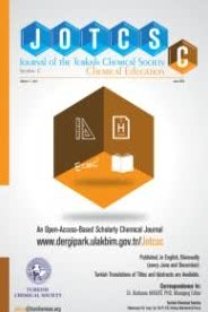Bir STEAM Uygulaması: Sürrealist Kimya
Öğrencilerin kimyayı öğrenebilmeleri, kimyanın submikroskobik doğasını zihinlerinde bilimsel olarak doğru bir biçimde yapılandırabilmelerine bağlıdır. Dolayısıyla bu araştırmada STEAM uygulamasıyla öğrencilerin submikroskobik imajlarının geliştirilmesi amaçlanmıştır. Bu amaçla makro ve submikro doğa sürrealist bir biçimde çalışılmıştır. Araştırma Ankara’da bir ortaöğretim kurumunda dört öğrenci ile nitel araştırma desenlerinden durum çalışması temelinde yürütülmüştür. Katılımcı grubun küçük tutulmasındaki amaç birden fazla sürrealist tablo çalışılacak olmasıdır. Araştırmanın veri toplama sürecinde öğrencilerin makro ve submikro doğayı harmanlama suretiyle STEAM felsefesi temelinde yapılandırdıkları tablolar araştırmanın veri toplama aracı olarak kullanılmıştır. Araştırmanın diğer veri toplama aracıysa katılımcı gözlemci gözlem notlarıdır. Tablolar içerik analizi tekniklerinden fotoğraf analizi ile çözümlenmiş, katılımcı gözlemci gözlem notları için de betimlemeler kullanılmıştır. Araştırma sonucunda STEAM uygulamasıyla sürrealist tablolar yapılandırma suretiyle öğrencilerin kısmen bilimsel submikroskobik imaj edindikleri bulunmuştur. Katılımcı gözlemci gözlem notları öğrencilerin öncesinde submikroskobik imajlarının çok zayıf olması sebebiyle ayrıntılı alanyazın taramasına ihtiyaç duymalarına, uygulama sonrasında ise imaj edinmeye dair anlamlı öğrenmeye vurgu yapmaları şeklindedir.
Anahtar Kelimeler:
Kimya öğretimi, STEAM, imaj geliştirme
A Science-Art Application: Surrealist Chemistry
In this research, it was aimed to enhance students’ submicroscopic images about chemistry through a science-art application. For this aim, macro and submicro nature were studied in a surrealist way on canvas through the science-art application. The research was conducted on four students educating at a high school in Ankara on the basis of the case study. The participants were a small group because of studying multiple surrealist paintings. The students constructed surrealist paintings by reflecting both of macro and submicro nature together. These paintings and participant-observer notes were used as data collecting tools. Photography content analysis was utilized for the paintings and descriptions were made for observer notes. At the end of the research, it was found that the students could gain partly scientifically true images by constructing surrealist paintings. Also, it could be said based on participant-observer notes that before the application, the students’ submicroscopic images were not adequate, so they needed the literature search. After the application, the students referred to meaningful learning by the help of images according to participant-observer notes.
Keywords:
Chemistry teaching, science-art application, enhancing images,
___
- Atasoy, B. (2004). Fen öğrenimi ve öğretimi. Ankara: Asil Yayın Dağıtım.
- Bilgin, N. (2006). Sosyal bilimlerde içerik analizi, teknikler ve örnek çalışmalar. Ankara: Siyasal.
- Boy G. A. (2013). From STEM to STEAM: Toward a human-centered education, Retrieved from https://ntrs.nasa.gov/search.jsp?R=20130011666 2017-09-10T16:59:03+00:00Z.
- Büyüköztürk, Ş., Kılıç-Çakmak, E., Akgün, Ö. E., Karadeniz, Ş. & Demirel, F. (2010). Bilimsel araştırma yöntemleri. Ankara: Pegem.
- Coskun Armutcu, Z. E., Kilic, M., Tuzun, U. N., & Tuysuz, M. (2018). Integrating science to art: Teaching science concepts to gifted by passing from macro to submicro level in their mental images. H. Sahin, A. Temizer & F. Erdogan (Eds.), Current academic studies in education sciences, (pp. 759-774). Montenegro: Cetinje.
- Erduran, S. (2009). Beyond philosophical confusion: Establishing the role of philosophy of chemistry in chemical education research. Journal of Baltic Science Education, 8(1), 5-14.
- Erduran, S., Bravo, A. A., & Mamlok-Naaman, R. (2007). Developing epistemology empowered teachers: Examining the role of philosophy of chemistry in teacher education. Science & Education, 16(9-10), 975-989.
- Nakhleh, M. B. (1992). Why some students don’t learn chemistry. Journal of Chemical Education, 69, 191-196.
- Piro, J. (2010), Going from STEM to STEAM, Education Week, March 10, Retrieved from http://www.ischoolcampus.com/wp-content/uploads/2010/03/Going-From-STEM-to-STEAM.pdf.
- Robelen E. W. (2011), STEAM: Experts make case for adding arts to STEM, Education Week, December 7, Retrieved from http://www.bmfenterprises.com/aep-arts/wp-content/uploads/2012/02/Ed-Week-STEM-to-STEAM.pdf.
- Başlangıç: 2016
- Yayıncı: Türkiye Kimya Derneği
